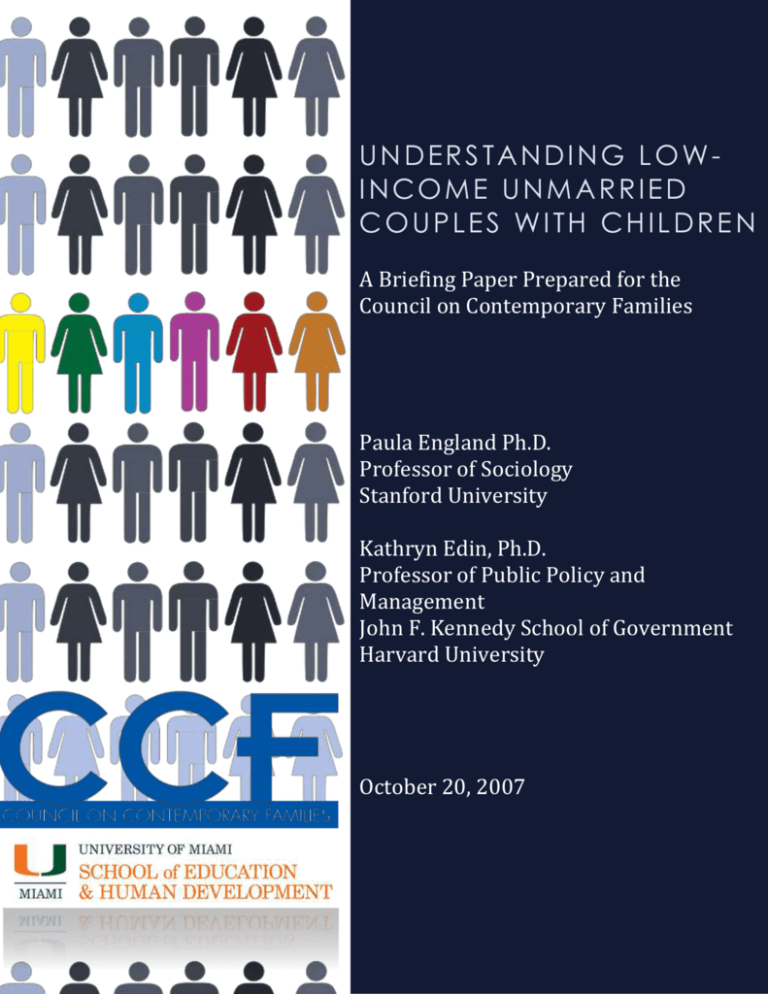
UNDERSTANDING LOWINCOME UNMARRIED
COUPLES WITH CHILDRE N
A Briefing Paper Prepared for the
Council on Contemporary Families
Paula England Ph.D.
Professor of Sociology
Stanford University
Kathryn Edin, Ph.D.
Professor of Public Policy and
Management
John F. Kennedy School of Government
Harvard University
October 20, 2007
UNMARRIED COUPLES WITH CHILDREN
ENGLAND & EDIN 2
Executive Summary
Why do so many low-income couples postpone marriage but fail to postpone childbearing?
Which couples eventually do marry? Why do the rest of the couples break up? How would
knowing the answers to these questions affect public policy?
A new briefing report by the Council on Contemporary Families offers an advance look at
the answers to these questions, based on research to be published in a forthcoming book
(October, 2007) by Stanford sociologist Paula England and Harvard sociologist Kathryn
Edin.
The report, "Unmarried Couples with Children," follows below. Among the questions to
which it provides surprising answers:
Why low-income unmarried couples with children believe they will have a longerlasting relationship if they postpone marriage, even after they have a child, and even
though most say they expect to marry each other;
Which couples are most likely to use contraception; and why some couples do not;
How the issues that eventually break most of these couples up differ from the issues
that initially cause them to postpone marriage;
Why liberal and conservative policy proposals for these couples each fail to address
half the problem.
Other topics covered in the study:
Couples who do not use birth control consistently are NOT the uncommitted couples
we often hear about, who have a short fling, leaving the woman pregnant and the
man long gone. It is the committed couples who do not regularly use birth control,
and the report explains why;
What issues create conflict for low-income couples with children, and why it is
women who usually initiate the breakup;
What predicts good fathering in a relationship when a man has a child from a
previous relationship, as so many of the men (and women) in these couples do.
Stephanie Coontz
Director of Research and Public Education
Council on Contemporary Families
UNMARRIED COUPLES WITH CHILDREN
ENGLAND & EDIN 3
Understanding Low-Income Unmarried Couples with
Children
Paula England, Ph.D.
Professor of Sociology
Stanford University
Kathryn Edin, Ph.D.
Professor of Public Policy and Management
John F. Kennedy School of Government
Harvard University
One third of babies born in the United States today have unmarried parents (Carlson et al.
2004), up from about 5 percent in 1960 (Moore 1995). The more economically
disadvantaged couples are, the more likely they are to be unmarried when their children
are born (Ellwood and Jencks 2004; Moore 1995). Thus, studying the relationships of
couples who have children outside marriage helps us understand a large group of lowincome couples. This briefing paper summarizes findings from a new book studying such
couples, entitled Unmarried Couples with Children, edited by Stanford sociologist Paula
England and Harvard sociologist Kathryn Edin, published in 2007 by Russell Sage
Foundation. Together with our assistants, we conducted in-depth interviews with
unmarried couples right after their baby was born, and followed and reinterviewed them
until their baby turned 4, whether they married, stayed together unmarried, or broke up.
Parents were interviewed together and apart.
Many of us have a stereotypical view of a woman having a baby out of wedlock-we assume
that unmarried fathers are long gone from the mothers' lives by the time of the birth. But,
in fact, nothing could be farther from the truth. A large national survey of nonmarital births
in 20 large urban areas, the Fragile Families and Child Wellbeing Study, found that over
80% of unmarried parents were romantically involved with the other parent when their
baby was born, and about half of the couples were living together at the time of the birth. Of
mothers romantically involved with the father at the birth, 78 percent of the cohabitors and
49 percent of those not living together said they saw at least a good or almost certain
chance that the two would marry sometime in the future (from mothers' reports; Carlson
and McLanahan 2002). An even higher percent of fathers predicted that the couple would
marry eventually. But, in fact, most couples did not marry within a few years and many
broke up. Among the approximately half of the unmarried parents in the larger Fragile
Families survey where the parents were cohabiting at the birth, five years after the baby is
born, almost half had broken up and only about a quarter had married. Among the
approximately 30 percent of unmarried parents who are romantically involved but not
cohabiting when their baby is born, over three quarters were broken up and only 7 percent
married to each other five years later.
Our qualitative study of 48 unmarried couples who shared a nonmarital birth in 2000 is
embedded in the Fragile Families study, discussed above, which sampled thousands of
births in hospitals in 20 cities, interviewing both parents where possible. We drew the
couples for our study from among the couples in the larger survey in three of the 20 cities.
Our study was called the "TLC3 Study" (for "Time, Love, and Cash Among Couples with
UNMARRIED COUPLES WITH CHILDREN
ENGLAND & EDIN 4
Children"). Our study included only couples who were still romantically involved when
their baby was born (as mentioned above, national data show this is true in about 80% of
nonmarital births). The average household income of TLC3 couples who were cohabiting
was quite low, $22,500. Twenty-nine percent of fathers and 26 percent of mothers had
neither a G.E.D. nor a high school degree. Thus, like unmarried parents nationwide, this is a
very disadvantaged group.
Are pregnancies planned? Our study started by asking whether the pregnancies that led to
the nonmarital births that our respondents had experienced were planned, unplanned, or
in between.[i] While a small number (12%) of the nonmarital conceptions are planned, most
are not. Those that were planned were almost universally to couples in serious
relationships. Twenty-two percent were the result of inconsistent contraception, most of
these to couples in serious relationships as well. These couples often use contraception
consistently when their relationship is new, but let their vigilance lapse when the
relationship becomes more serious. Eighteen percent had used contraception but it failed;
another five percent had thought they were sterile, so weren't contracepting. One of the
most important findings as that roughly another 25% were neither planned nor unplanned,
but in between. That is, there is a continuum of how "intended" pregnancies are.
Individuals characterizing the pregnancy as "in between" are almost always in a serious
relationship and want children together eventually. Unsure that their current
circumstances are ideal, their ambivalence leads them to leave conception to chance.
A quarter of the pregnancies were truly unintended, but occurred when couples were not
contracepting. These individuals did not want-even ambivalently-to have a child now, but
somehow didn't align their contraceptive behavior with their wishes. These are the
pregnancies where abortion is most often considered or pursued. The group of parents
having these pregnancies have the least efficacy in achieving their own goals and some are
caught up in lifestyles that are risky in many ways.
Overall, we identified two important factors affecting whether unmarried individuals have
children. One is how serious their relationship is. The more serious it is, the more likely
they are to have a child, even while unmarried, and to have a pregnancy that is truly
planned or at least "in between" planned and unplanned. The second factor is individuals'
degree of efficacy in "getting it together" to contracept consistently when they truly did not
want a pregnancy.
Will They Marry Later? Do couples who are together but unmarried when their baby is
born aspire to marriage with this partner? Most truly do, but not many tie the knot. So we
explored what they say about what is keeping them from marrying.[ii] For some, problems
with the relationship held them back. But the even more common-almost universalresponse by men and women to our questions about what it would take for them to decide
to marry was that they were waiting to meet certain economic standards. Of course, the
idea that couples need to be able to afford to set up a household and support a child before
getting married has long been traditional. What is interesting about today's unmarried
couples who've had a child together is that they articulate this standard for marriage even
when they have already started living together and have had a child together. Indeed,
UNMARRIED COUPLES WITH CHILDREN
ENGLAND & EDIN 5
couples who hadn't married four years after their baby's birth, but hadn't broken up either,
still clung to this bar as a major reason they hadn't married yet. What parents meant by this
economic bar was usually something like wanting one or both of them had a good job so
they didn't need family or friends or the government to give them money to pay all their
bills each month. Based on how they described their economic situation, the study
classified parents into those who met this bar by four years after the baby was born and
those who did not. Most of the parents in the study did not meet this economic bar by four
years after the birth, and did not marry. But 78 percent of those who met this bar married,
while only 19 percent of those who did not meet the bar did so by four years after the birth.
Given their values and criteria, the inability to get decent paying jobs is a real constraint to
marriage among low income unmarried parents.
What Do They Fight About? We also looked at what issues create conflict for low-income
couples with children.[iii] After the interviews with the couples still together three and four
years after their baby's birth, interviewers asked couples to identify the two most
important issues that they don't see eye to eye on. The video camera continued to run
while the interviewer left the room for 10 minutes, leaving the couple to discuss the issue.
The four issues that came up most often were emotional attention and companionship,
child discipline, housework, and money issues. Earlier studies suggested that it is only in
the middle class that women expect emotional intimacy and shared activities with men. But
this has clearly changed. The low income women in our study complained bitterly that
their men don't listen to them or talk to them enough, and don't spend "quality time" with
them. Women also complained about men spending time "on the street" or with male
friends or kin rather than with them. Child discipline was another hot issue. Men generally
wanted a stricter regime than women. Either Dad wanted Mom to run a tighter ship while
doing the child minding that they both agreed was her job, or Dad himself wanted to
discipline children (especially sons) more harshly than Mom thought was appropriate.
Fathering When Dad Lives with Mom.[iv] We also zeroed in on how involved Dads are in
taking care of children when the couple is living together. The worst couple relationships
with the most conflict had the least and lowest quality father involvement. However, at the
opposite end of involvement, the very most involved fathers, who did at least half the child
care, were not the ones with the best (nor the worst) relationships. The most involved dads
were in couples where she was employed and he was unemployed. His nonemployment
was not usually a based on a choice that he would be the one to stay home with children,
but a result of not finding a job or being employable. The care work done by these fathers is
appreciated by the mother, but the men often have economic and behavioral problems that
strain their relationships. When men are employed, the father's primary role is typically as
a "playmate" to the child who does actual care mostly only when mothers scrutinize and
supervise their work.
Unmarried Step Parenting.[v] Many of the cohabiting couples in our study lived in a
household including not only the baby they had together, but also Mom's child from a prior
relationship. Often Dad also had a child from a prior relationship, although typically this
child was living with his female ex-partner. Jealousy is often the cause of conflicts in these
"blended" families. When Dad goes to see his other children by a previous woman, his
UNMARRIED COUPLES WITH CHILDREN
ENGLAND & EDIN 6
current partner is jealous of the time away from her and her kids, and she may worry that
he will get sexually and romantically reinvolved with his "ex." Dad, too, may be jealous
about his new partners' dealings with her "ex" with whom she has a child, for example,
when he comes by to pick up children for visitation. Among couples with blended families,
those who married each other were those in which Mom's prior partner was no longer an
active father to her kids and Dad was no longer involved with any of his kids who live with
their mother. This poses a dilemma-it appears that a good way to encourage marriage
among new unmarried parents is to encourage fathers to be "dead-beat dads" to their kids
by former partners, hardly a compelling policy suggestion. What is best for his kids by one
partner may not be best for his kids by the new partner.
Jealousy and Cheating.[vi] American couples in committed romantic relationships
overwhelmingly expect sexual exclusivity regardless of their marital status, though
infidelity is higher among unmarried than married couples. More than half (58%) of the
unmarried couples in our study had experienced at least one instance of infidelity over the
course of their relationship. Most of the time it was men who cheated, though some women
did as well. Incidents of infidelity often occurred around events that brought the future of
the relationship into question, such as the incarceration of one partner or a major
argument. If there was chronic infidelity, the relationship seldom survived. Sexual jealousy
and sexual mistrust are even more pervasive than reports of actual infidelity, with at least
one of the partners in three quarters of the couples reporting some such issue.
What Leads To Breakups Among Unmarried Parents?[vii] Respondents who had broken up
with the other parent reported infidelity, arguing, verbal and physical abuse, lack of love
and attention, and substance abuse as primary reasons for their break ups. Often those who
broke up had multiple problems. Relationship quality is central, and men's bad behavior is
key. It is almost always women who initiate the breakup, and the men who move out.
Although economic problems figure prominently in why couples say they don't get
married, economic problems were never central to their stories of how the breakup
occurred. Not surprisingly, couples who broke up had much worse relationships at the
outset. Indeed, it appears that the bad relationships were usually bad from the beginning,
and over half the breakups that occurred within four years actually happened in the first
year after the baby's birth.
Do Unmarried Dads Pay Child Support After a Breakup?[viii] We found little evidence of
fathers with decent jobs who could support their children but choose not to pay any child
support-the stereotypical "dead beat dad." However, this may be at least in part because
child support systems are now sufficiently stringent that those who are employed have
support automatically garnished from their wages. We don't know how many of these
fathers would have paid in a less stringent regime. For those not paying, both mothers and
fathers point to incarceration, unemployment, and a lack of resources as reasons for the
low levels of support. However, fathers portray their contributions in a much more positive
light than their female ex-partners do. Most young mothers without support from fathers
are relying on a new partner to help provide for their families by the time their babies were
4 years old. However, we couldn't really tell whether having the new partner caused her to
UNMARRIED COUPLES WITH CHILDREN
ENGLAND & EDIN 7
stop trying to get her former partner to pay child support, or whether the lack of his child
support increased her motivation to find a new partner; the causal order was unclear.
Do Dads Visit their Kids After Breakup?[ix] At the time of a child's birth, most unmarried
fathers are dedicated to staying involved with their child, and most mothers want them to
as well. Yet studies consistently show that as children whose parents are separated grow
older, manyt fathers disconnect, particularly those who were never married to the mother.
Our study considered two sides of the story of how fathers become uninvolved, offering a
rare "he said, she said" account. Fathers blame mothers, and charge them with
"gatekeeping," while mothers say there are good reasons for limiting fathers' access to
their children. Mothers offer three main justifications for their gate-keeping: previous
inconsistency in visitation, safety concerns about the dangers associated with the father's
lifestyle (usually his drug or alcohol use), and the inability of the parents to get along after
the breakup. While one might assume that safety concerns would prompt mothers to
completely shut fathers out, this was not so. In fact, fathers whose contact was limited for
these reason alone often had some degree of contact, though mothers controlled when the
contact occurred. These mothers usually arranged for the fathers to visit in the mother's
home. It was when the two parents just couldn't get along that fathers were most likely to
be shut out completely, sometimes through the mother getting a restraining order against
the father. Some fathers claimed that these orders were obtained fraudulently. Most
mothers who "gate-keep" their children's fathers out have repartnered, and the existence
of a new man is straining an already tenuous coparenting relationship. In cases where no
gatekeeping is evident, mothers say they value the role the father plays in the child's life
and they are sometimes reliant on the fathers for childcare.
Our Study Compared To What We Know About Low Income Families in Past Decades. In
earlier decades, it was common for unmarried low income couples to find the woman
pregnant out of wedlock, just as our unmarried sample members did. But intercourse
typically would not have started until relationships were more serious (Hollingshead
1949). Within or outside of marriage, though, having children only when planned has long
been more frequent in the middle than working and lower class (Rainwater 1960, 1965).
Like decades ago, it is common today for low income couples to get pregnant without
explicitly planning it, inside or outside marriage. One thing contributing to the increase in
nonmarital births is the reduction in how often pregnancies prompt couples to move to
marriage or to stable common law arrangements (Moore 1995; Akerlof et al. 1996). The
extent to which the sexual revolution reduced shot-gun marriages underscores the degree
to which these marriages in earlier eras reflected the shame entailed in having premarital
sex revealed, shame that was heaped particularly on the women.
Our study suggests that the meaning of marriage has changed. As long as they are still
romantically involved, unmarried parents almost always see marriage to the co-parent as
something to aspire to, but they don't want to marry until certain relational and economic
bars are met, even when they are already living together and have a child together. In
contrast, in earlier decades, one virtually had to be married and have children to "count" as
a social adult (Morland 1958). Today, marriage is seen as more optional, but its symbolic
value has increased (Cherlin 2004; Edin and Kefalas 2005). People feel it is worse to marry
UNMARRIED COUPLES WITH CHILDREN
ENGLAND & EDIN 8
before the couple's relational and economic status are above a certain threshold than it is
to have a child while unmarried (Edin and Kefalas 2005; Gibson et al. 2006; Edin 2000).
Rising emotional standards for marriage are a continuation of a longterm trend; Coontz
(2005) argues that the trend dates all the way back to the love revolution of the eighteenth
century. But, while love was the ideal, ethnographies of the 1950s and 1960s pointed out
how little companionship and shared leisure there often was between low-income spouses
(Bott 1957; Gans 1962). Women often resigned themselves to little mutuality and
considered themselves lucky if their men brought home most of their paycheck and didn't
beat them (Komarovsky and Phillips 1962; Rubin 1976). Today's low income women,
black, white, and Hispanic, clearly have much higher relationship standards. Indeed, in our
study, women's top complaint was that men didn't talk to them enough, show enough
affection, and spend enough "quality time" with them. It is probably not that today's
relationships among low income couples are worse than those of prior decades. Part of the
problem is that the earnings of men in the bottom half of the class hierarchy have fallen
since the 1970s (Bernhardt et al. 2001), but this explains only some of the retreat from or
delay of marriage (Ellwood and Jencks 2004). Rising cultural standards are also key to the
explanation. As modest as the standards of the couples we study here seem, they are
undoubtedly much higher than those held by their counterparts decades back (Edin and
Kefalas 2005). Given that relational and economic problems are worse toward the bottom
of the class structure, as they have always been, todays' rising emotional and economic
standards for marriage have left many low income couples in the situation where neither
their relationships nor their budgets meet their own standards for marriage.
UNMARRIED COUPLES WITH CHILDREN
ENGLAND & EDIN 9
References
Akerlof, George A., Janet L. Yellen, and Michael L. Katz. 1996. "An analysis of out-of-wedlock
childbearing in the United States." Quarterly Journal of Economics 111(2): 277-317.
Anderson, Elijah. 1989. "Sex Codes and Family Life among Poor Inner-City Youths." Annals
of the AmericanAcademy of Political and Social Science 501:59-78.
-. 1990. Streetwise: Race, Class, and Change in an Urban Community. Chicago: University of
Chicago Press.
Becker, Gary. [1981] 1991. A Treatise on the Family. Enlarged Edition. Cambridge, MA:
HarvardUniversity Press.
Bernhardt, Annette, Martina Morris, Mark S. Handcock, and Marc A. Scott. 2001. Divergent
Paths: Economic Mobility in the New American Labor Market. New York: Russell
Sage Foundation.
Bott, Elizabeth. 1957. Family and Social Network: Roles, Norms, and External Relationships
in Ordinary Urban Families. London: Tavistock.
Bachu, Amara, 1999. "Trends in Premarital Childbearing 1930-1994." Current Population
Reports, Special Studies, series P23, no. 197. Washington, DC: U.S. Government
Printing Office for U.S. Bureau of the Census.
Caplow, Theodore, Howard M. Bahr, Bruce A. Chadwick, Reuben Hill, and Margaret Holmes
Williamson. 1982. Middletown Families: 50 Years of Change and Continuity.
Minneapolis: University of Minneapolis Press.
Carlson, Marcy and Sara McLanahan. 2002. "Fragile families, Father Involvement and Public
Policy." In Handbook of Father Involvement: Multidisciplinary Perspectives, edited
by Catherine S. Tamis-LeMonda and Natasha Cabrera. Mahwah, New Jersey:
Lawrence Erlbaum.
Carlson, Marcia, Sara S. McLanahan, and Paula England. 2004. "Union Formation in Fragile
Families." Demography 41:237-261.
Cherlin, Andrew J. 2004. "The Deinstitutionalization of American Marriage." Journal of
Marriage and Family 66: 848-861.
Collins, Patricia Hill. 1990. Black Feminist Thought: Knowledge, Consciousness, and the
Politics of Empowerment. New York: Routledge.
Commission on Behavioral and Social Sciences and Education. 1989. Trends in Premarital
Sexual Behavior. Washington, D.C.: NationalAcademy of Sciences Press.
Drake, St. Claire and Horace R. Cayton. [1945] 1962. Black Metropolis: A Study of Negro Life
in a Northern City. New York: Harper.
DuBois, WEB. [1899] 1967. The Philadelphia Negro: A Social Study. New York: Schocken.
Edin, Kathryn and Maria Kefalas. 2005. Promises I Can Keep: Why Poor Women Put
Motherhood Before Marriage. Berkeley, CA: University of California Press.
Edin, Kathryn and Joanna M. Reed. 2005. "Why Don't They Just Get Married? Barriers to
Marriage among the Disadvantaged." Future of Children 15(2): 117-137.
Ellwood, David and Christopher Jencks. 2004. "The Spread of Single-Parent Families in the
United States since 1960." Pp.25-65 in The Future of the Family, edited by Daniel P.
Moynihan, T. Smeeding, and Lee Rainwater. New York: Russell Sage.
Frazier, E. Franklin. [1939] 1966. The Negro Family in the United States. Chicago:
University of Chicago Press.
UNMARRIED COUPLES WITH CHILDREN
ENGLAND & EDIN 10
Furstenberg, Frank F., Jr. 1976. Unplanned Parenthood: The Social Consequences of
Teenage Childbearing. New York: Free Press.
Gans, Herbert J. 1962. The Urban Villagers. Glencoe, IL: The Free Press.
Gibson, Christina, Kathryn Edin and Sara McLanahan. 2006. "High Hopes but Even Higher
Expectations: A Qualitative and Quantitative Analysis of the Marriage Plans of
Unmarried Couples Who are New Parents." Journal of Marriage and Family 67(5):
301-1312.
Goldin, Claudia and Lawrence F. Katz. 2002. "The Power of the Pill: Contraceptives and
Women's Career and Marriage Decisions." Journal of Political Economy 110(4): 730770.
Gupta, Sanjiv. Forthcoming. "Autonomy, Dependence, or Display? The Relationship
Between Married Women's Earnings and Housework." Journal of Marriage and
Family.
Halle, David. 1984. America's Working Man: Work, Home, and Politics among Blue-Collar
Property Owners. Chicago: University of Chicago Press.
Hannerz, Ulf. 1969. Soulside: Inquiries into Ghetto Culture and Community. New York:
ColumbiaUniversity Press.
Hirsch, Jennifer. 2003. A Courtship after Marriage: Sexuality and Love in Mexican
Transnational Families. Berkeley, CA: University of California Press.
Hollingshead, A.B. 1949. Elmtown's Youth. New York: John Wiley and Sons.
Horowitz, Ruth. 1983. Honor and the American Dream. New Brunswick, NJ:
RugersUniversity Press.
Howell, Joseph T. 1973. Hard Living on Clay Street. Garden City, NY: Anchor Books.
Komarovsky, Mirra and Jane H. Phillips. 1962. Blue Collar Marriage. New Haven, CT:
YaleUniversity Press.
Kurz, Demie. 1995. For Richer, For Poorer: Mothers Confront Divorce. New York:
Routledge.
Laumann, Edward O., John H. Gagnon, Robert T. Michael, and Stuart Michaels. 1994. The
Social Organization of Sexuality: Sexual Practices in the United States. Chicago:
University of Chicago Press.
Ladner, Joyce. 1971. Tomorrow's Tomorrow: The Black Woman. Garden City, NY:
Doubleday.
Leibow, Eliot. 1967. Tally's Corner: A Study of Negro Streetcorner Men. New York: Little,
Brown.
LeMasters, E.E. 1975. Blue Collar Aristocrats: Lifestyles at a Working Class Tavern.
Madison, WI: University of Wisconsin Press.
Lewis, Oscar. 1965. La Vida: A Puerto Rican Family in the Culture of Poverty-San Juan and
New York.New York: Random House.
Lynd, Robert S. and Helen Merrell Lynd. 1929. Middletown: A Study in Modern American
Culture. New York: Harcourt Brace Jovanovich.
McLanahan Sara. 2004. "Diverging Destinies: How Children Are Faring Under the Second
Demographic Transition." Demography 41(4):607-27.
Mincy, Ronald B. 1994. "Strengthening Fragile Families: A Proposed Strategy for the Ford
Foundation Urban Poverty Program." New York: Ford Foundation.
UNMARRIED COUPLES WITH CHILDREN
ENGLAND & EDIN 11
Morgan, S. Philip, A. McDaniel, A.T. Miller, and S. Preston. 1993. "Racial Differences in
Household and Family Structure at the Turn of the Century." American Journal of
Sociology 98(4):798-828.
Morland, John Kenneth. 1958. Millways of Kent. Chapel Hill: University of North Carolina
Press.
Moore, Kristin A. 1995. "Executive Summary: Nonmarital Childbearing in the United
States." Pp. v-xxii in U.S. Department of Health and Human Services, Report to
Congress on Out-of-Wedlock Childbearing. DHHS Publication Number (PHS) 951257. WashingtonD.C.: U.S. Government Printing Office.
Pagnini, Deanna and S. Philip Morgan. 1996. "Racial Differences in marriage and
childbearing: oral history evidence from the South in the early twentieth century."
American Journal of Sociology 101:1694-1718.
Powdermaker, Hortense. [1939] 1969. After Freedom: A Cultural Study of the Deep South.
New York: Atheneum.
Preston, Samuel H., Suet Lim and S. Philip Morgan. 1992. "African-American Marriage in
1910: Beneath the Surface of Census Data." Demography 29:1-15.
Rainwater, Lee. 1960. And the Poor Get Children: Sex, Contraception, and Family Planning
and the Working Class. Chicago: Quadrangle Publications.
-. 1965. Family Design: Marital Sexuality, Family Size and Contraception. Chicago: Aldine.
-. 1970. Behind Ghetto Walls: Black Family Life in a Federal Slum. New York: Aldine.
Raley, R. Kelly and Larry Bumpass. 2003. "The Topography of the Divorce Plateau: Levels
and Trends in Union Stability in the United States after 1980." Demographic
Research 8:245-259.
Rubin, Lillian B. 1976. Worlds of Pain: Life in a Working-Class Family. New York: Basic
Books.
Ruggles, Steve. 1994. "The Origins of African American Family Structure." American
Sociological Review 59(1): 136-151.
Shafer, Emily Fitzgibbons. 2006. "Are men or women more reluctant to marry in couples
sharing a non-marital birth?" Gender Issues 23(2): 20-43.
U.S. Department of Health and Human Services. 1995. Report to Congress on Out-ofWedlock Childbearing. Publication Number (PHS) 95-1257. WashingtonD.C.: U.S.
Government Printing Office.
Waller, Maureen R. 1999. "Meanings and Motives in New Family Stories: The Separation of
Reproduction and Marriage among Low-Income, Black and White Parents." Pp. 182218 in The Cultural Territories of Race: Black and White Boundaries, edited by
Michèle Lamont. Chicago: The University of Chicago Press.
-. 2002. My Baby's Father: Unmarried Parents and Paternal Responsibility. Ithaca, NY:
CornellUniversity Press.
Wu, Larry and Barbara Wolfe (Eds.) 2001. Out of Wedlock: Causes and Consequences of
Nonmarital Fertility. New York: Russell Sage Foundation.
UNMARRIED COUPLES WITH CHILDREN
ENGLAND & EDIN 12
Endnotes
[i] Whether the pregnancies were planned is discussed in the chapter entitled "Forming
Fragile Families: Was the Baby Planned, Unplanned, or In-Between?" by Kathryn Edin,
Paula England, Emily Shafer, and Joanna Reed. Respondents were asked about all their
nonmarital births, abortions, or miscarriages.
[ii] What unmarried parents say about what is keeping them from marrying is explored in
the chapter entitled "Expectations and the Economic Bar to Marriage Among Low-Income
Couples" by Christina Gibson-Davis.
[iii] The content of relationship conflicts was explored in the chapter entitled "Everyday
Gender Conflicts in Low-Income Couples," by Paula England and Emily Shafer. This chapter
used the unmarried couples as well as a comparison sample of married couples who had
babies in the same urban hospitals, since the content of their conflicts was not significantly
different.
[iv] This topic is examined in the chapter entitled ""#1 Father or Fathering 101: Couple
Relationship Quality and Father Involvement When Fathers Live with their Children" by
Kathryn Linnenberg. It too included married and unmarried parents.
[v] Households with unmarried step-parents are explored in Lindsay Monte's chapter
entitled "Blended But Not the Brady's: Navigating Unmarried Multiple Partner Fertility,"
[vi] Cheating and jealousy about possible cheating are discussed in the chapter by Heather
Hill entitled "Steppin' Out: Infidelity and Sexual Jealousy among Unmarried Parents."
[vii] The stories of the couples in the study who broke up are chronicled and analyzed in
the chapter entitled "Anatomy of the Breakup" by Joanna Reed.
[viii] Child support payment is explored by Katherine Magnuson and Christina GibsonDavis in the chapter entitled "Child Support Paatterns Among Low-Income Noncustodial
Fathers."
[ix] This is explored in the chapter entitled "Gate-keeper Moms and (Un)Involved Dads:
What Happens After a Breakup?"by Amy Claessens..
UNMARRIED COUPLES WITH CHILDREN
ENGLAND & EDIN 13
About the Author
Paula England Ph.D.
Professor of Sociology
Stanford University
Phone: 650.723.4912 or 650.815.9308
Email: pengland@stanford.edu
Kathryn Edin, Ph.D.
Professor of Public Policy and Management
John F. Kennedy School of Government
Harvard University
Phone: 215.908.1916
Email: Kathy_Edin@ksg.harvard.edu
Media Contact
Stephanie Coontz
Director of Research and Public Education
Council on Contemporary Families
Phone: 360 352-8117, 360 556-9223
Email: coontz@msn.com
About CCF
The Council on Contemporary Families is a non-profit, non-partisan organization dedicated to
providing the press and public with the latest research and best-practice findings about
American families. Our members include demographers, economists, family therapists,
historians, political scientists, psychologists, social workers, sociologists, as well as other family
social scientists and practitioners.
Founded in 1996 and now based in the School of Education and Human Development at the
University of Miami, the Council's mission is to enhance the national understanding of how and
why contemporary families are changing, what needs and challenges they face, and how these
needs can best be met. To fulfill that mission, the Council holds annual conferences, open to
the public, and issues periodic briefing papers and fact sheets.
Access our publications and learn more about CCF membership at
www.contemporaryfamilies.org







